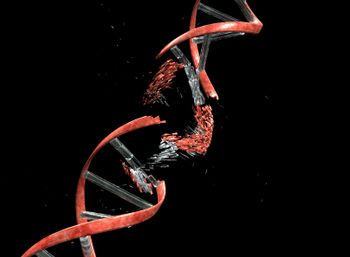
According to a recent analysis by researchers at the National Cancer Institute, in 2020, medical expenditures for cancer should reach at least $158 billion (in 2010 dollars). This represents an increase of 27 percent over 2010.

Your AI-Trained Oncology Knowledge Connection!


According to a recent analysis by researchers at the National Cancer Institute, in 2020, medical expenditures for cancer should reach at least $158 billion (in 2010 dollars). This represents an increase of 27 percent over 2010.

A new study finds that cancer cells, conventionally thought to develop only over long periods of time can begin in a single event, accounting for the development of 2% to 3% of all cancers, and up to 25% of bone cancers.


"Kinome" is the word to know this year in oncology, because it has begun to reveal molecules that some tumors are relying on to survive, which until now we had no idea were involved in cancer or which we hardly knew at all.

European regulators have approved rituximab(MabThera or Rituxan) as a first-linemaintenance treatment for patients withfollicular lymphoma (FL) whose disease hasresponded to initial induction therapy.

Patients with myelofibrosis experienced relief from pain, fatigue, and other symptoms associated with enlarged spleens after treatment with a JAK1 and JAK2 inhibitor, according to study results from Houston’s M.D. Anderson Cancer Center.

The Duke Comprehensive Cancer Centerin Durham, N.C., has received a five-year,$30 million core grant renewal from NCIto support its clinical, research, and educationalprograms.

Jeff Kranau’s story is a moving one but, during this economic downturn, not necessarily a unique one. The former South Florida salesman was successfully treated for squamous cell carcinoma of the larynx in 2009 and declared cancerfree. But what should have been a reason for celebration has, over time, sent Mr. Kranau’s life into a tailspin.

The John Theurer Cancer Center at Hackensack University Medical Center in New Jersey opened its new $130-million comprehensive care facility.

Like the protective plastic cap at the ends of shoelaces that prevent them from unraveling, telomeres protect the ends of chromosomes. These small strips of DNA prevent chromosome tips from fraying during cell division. But as the cells divide, the telomeres shorten and the cells age. Shortened telomeres have been linked to an increased risk of cancer development. Researchers at the Mayo Clinic in Rochester, Minn., wanted to see if telomere shortening was linked to colon cancer development at a younger age.

After resection for cancer or peptic ulcer disease, the mucosa of the gastric stump is considered prone to the development of gastric cancer precursor lesions (see Fact box), most likely because of exposure to Helicobacter pylori infection. Italian researchers set out to determine if the risk of gastric cancer recurrence was greater in the stump in the presence of HP infection.

Enlivening the public discussion about cancer biobanking will speed up the collection of specimens for research supporting the goal of personalized medicine. Biobanking is particularly important in minority populations, who experience a disproportionally greater burden of cancer incidence and mortality. But rather than unilaterally creating and launching a public education program, community medicine specialists in Florida first solicited public input.

One of the world's largest providers of medical services and information technologies sees strong growth in oncology services in the coming years, growth that can be leveraged into profits with the right blend of productivity and cost efficiency tools. With this in mind, McKesson plans to spend more than $2 billion to purchase the largest community-based cancer treatment and research network in America.

A program initiated at the Dan. L. Duncan Cancer Center in Houston, Texas, raised the participation of African-American and Hispanic patients in clinical trials to levels that approached that of the general population of the center's catchment area.

Finding an effective treatment for all the complex iterations of cancer is akin to chasing an outlaw through a treacherous mountain range, in the estimation of Louis M. Weiner, MD, director of the Georgetown Lombardi Comprehensive Cancer Center in Washington, DC.

NEW YORK-Turkey tail, healing touch, and liquidambar stryraciflua are areas in complementary medicine that are worth keeping an eye on, according to integrative oncology experts. The Society for Integrative Oncology (SIO) named five abstracts as its best during its 2010 meeting.



In the era of evidence-based medicine, clinical guidelines, and personalized medicine, one would think that convincing clinical trial data would influence clinical practice if disseminated in an appropriate manner. However, it has been estimated that only 50% of current medical practice is evidence-based, clearly demonstrating a compelling need to collect and analyze additional data to better inform practice. Current data are usually gathered from a variety of sources, including clinical trials, observational studies, and meta-analyses. Yet according to Jeff Forringer, CEO of IntrinsiQ, data from oncology practices provide real-world outcomes that give better insight into the efficacy of cancer therapeutics.

The berries of Lycium barbarum, a perennial plant native to Asia and southeastern Europe, have been used for centuries in traditional Chinese medicine to treat poor vision, anemia, inflammation, and cough. They are also consumed as food and used in soup recipes.

This timely manuscript by Bunnell and Shulman highlights critical issues that challenge our ability to provide care to cancer patients in the next 20 years. Each of the concerns the authors identify has a momentum of its own. In combination, they have the makings of a perfect health care storm. The time to further address these matters is now.

There is concern and growing evidence that the supply of medical oncologists in the United States will be insufficient to meet the needs of future patients. With an aging population and increasing complexity of cancer therapies, it is clear there will be more patients and that they will live longer and require expert care. It is equally clear that the number of specialists trained in cancer medicine is not growing fast enough to meet projected needs, so new models of care will need to be designed and implemented. Innovation in practice models will require the integration of non-physician practitioners (nurse practitioners and physician assistants) into multidisciplinary teams, broader use of technology to allow virtual consultations and the secure exchange of vital health information, increased utilization of community services, and public acceptance.

The number of cancer patients and cancer survivors continues to increase rapidly amid predictions of a shortfall in physicians to care for them. In addition, newer cancer therapies have become increasingly complex and resource-intensive, compounding the impending workforce shortage. Simultaneously, the growing understanding of the biologic heterogeneity of cancer and the development of pharmacogenomics have opened up the possibility of personalized approaches to cancer diagnosis and treatment. Such personalization has been promulgated as a means of decreasing the cost of drug development, improving the efficacy of treatments, and reducing treatment toxicity. Although there have been notable successes, the fulfillment of these promises has been inconsistent. Providing care for future cancer patients will require the development of innovative delivery models. Moreover, new approaches to clinical research design, to the assessment of therapeutic value, and to the approval of and reimbursement for diagnostics and treatments are needed.

Recent studies have shed new light on the role of histology in predicting sensitivity to therapeutic agents such as pemetrexed (Alimta) or bevacizumab (Avastin). Whereas during the past 30 years, the only useful histologic consideration was the absence or presence of a “non” before “small-cell lung cancer,” two US Food and Drug Administration (FDA)-approved drugs now have histologic restrictions. In this issue of ONCOLOGY, Selvaggi and Scagliotti provide an interesting review on how an old tool such as histology has recently emerged as a new criterion for treatment decisions in metastatic non–small-cell lung cancer (NSCLC). However, recent experience with tyrosine kinase inhibitors (TKIs) targeting the epidermal growth factor receptor (EGFR) demonstrate that we need to move beyond histology to improve outcomes for patients with advanced NSCLC.

Exploring the Clinical Decisions of US Community-Based Oncologists and Hematologists in the Management of Multiple Myeloma and Follicular LymphomaSupported by educational grants from Celgene Corporation, Cephalon Inc, and Millennium Pharmaceuticals Inc


An update of a long-term denosumab (Xgeva) trial offers another bisphosphonate as an alternative to zoledronic acid (Zometa) that is more convenient, less toxic, and more effective in bone metastases. But oncologists need to perform an oral exam of patients with bone metastases before placing them on denosumab.


Results from the GINECO group study demonstrate Afinitor’s ability to buy more time for patients while Xgeva makes everyday life less painful.

Our experts comment on the recent IOM report: Dietary Reference Intakes for Calcium and Vitamin D.